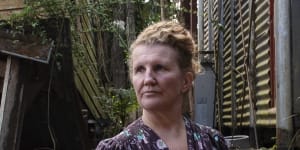The suburb was flood-prone but,in her elevated house,she felt she and her disabled son were safe. That all changed on February 28.

North Lismore resident Maralyn Schofield’s home was destroyed by flooding. She wants to be part of the buyback scheme to let her move out of the flood zone.Elise Derwin
“Standing neck deep in water,in a house 13 metres in the air,waiting for the SES to come,changed my view somewhat,” she noted dryly.
Now she’s ready to leave,and eager to take advantage of the NSW government has flagged will be part of its responsein February and March,damaging almost 11,000 homes and leaving 4055 uninhabitable.
But Lismore residents and community leaders are frustrated that,five months after the flood,Premier Dominic Perrottet has not yet released the 700-page independent flood inquiry report,and that detail on any scheme to help residents move forward is scant.
More than 1000 people are still homeless and living in emergency accommodation after the natural disaster,while others are staying with family and friends or camping out on their properties.

The state government has flagged a further $3 billion will be needed to help the Northern Rivers recover from the floods and it is expected to ask the federal government to help foot the bill.
Lismore City mayor Steve Krieg said his council wanted to help with a long-term recovery plan for Lismore but it had no capacity to contribute financially.
“When you’re talking about the size and scale of Lismore LGA alone,no council anywhere can afford to even partially fund that,” Krieg said.
Blocks of privately owned land had been identified on the outskirts of Lismore that could be used to permanently rehome flood-affected residents,Krieg said.

Steve Krieg on the streets of Lismore in the days after the flood.Elise Derwin
“There are people who have been sitting on some suitable land for a long time,saying that now is an opportunity to open that up,” Krieg said.
The council said in May that about 1000 homes would need to be rebuilt off the floodplain,at a cost of $400 million.
The challenge with any buyback or land-swap scheme would be meeting demand,according to Resilient Lismore,a grassroots group helping with recovery.
“Lots of people are ready to go,” co-ordinator and Lismore city councillor Elly Bird said. “They’re just waiting to see what the government will deliver before they decide what they’ll do.
“We know Queensland moved very quickly with a program around buybacks and land swaps,and here we are,still waiting.
“We’d like to see that[independent inquiry] report. That’s our report,our submissions that we put in,and we want to see the results.”
Krieg also called on the government to release the report in its entirety,saying his community needed certainty after five months in limbo.
“People have been holding off making big decisions about their homes and their businesses,waiting for this report.”
Labor state MP Janelle Saffin said purchase prices in a buyback scheme had to be based on pre-flood property valuations,a sentiment echoed by residents.
Schofield said many of the flood-affected parts of Lismore were low-socioeconomic areas and any buyback or land swap scheme had to ensure people had enough money to pay off their debts and start again.
”If you still have to pay your bank[exit] clause in the mortgage,buy a piece of land and build,that will be out of reach for I’d say 90 per cent of people in North and South Lismore.”
She is back living in two rooms of her home,but without any walls,and said she and her neighbours were frustrated waiting for details on what help would be coming their way.
“A week when you’re living like this is a very long time. It’s incredibly stressful. A lot of people are really anxious about their futures.”
She would ideally like to take part in a land swap and move her house with her.
“A lot of us have beautiful old homes built 120 years ago and some of them are still in very good nick. And the community doesn’t necessarily want to separate from each other.
“If we had a magic wand,I think there’s a big percentage who would stay fairly close to where we are now,just out of the flood.”

The Morning Edition newsletter is our guide to the day’s most important and interesting stories,analysis and insights..